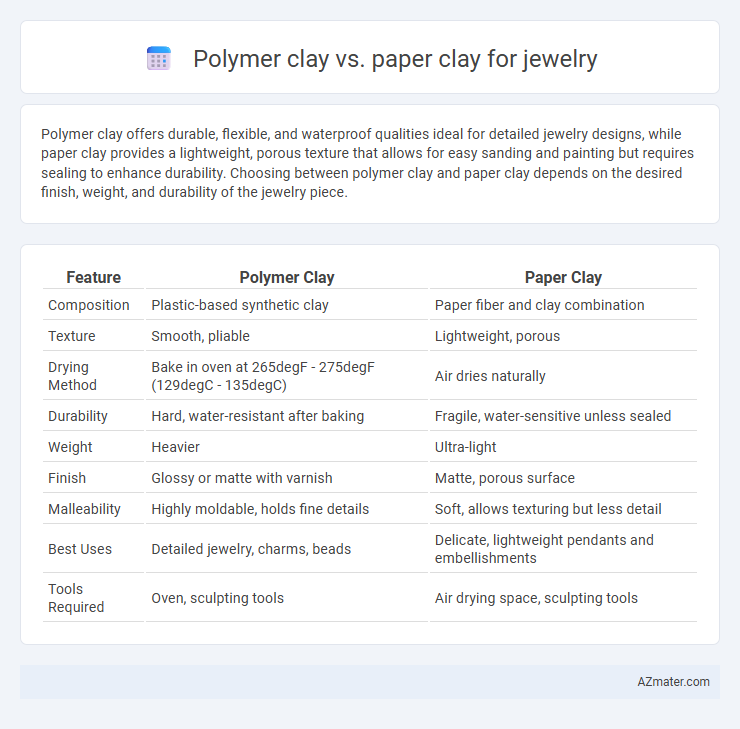Polymer clay offers durable, flexible, and waterproof qualities ideal for detailed jewelry designs, while paper clay provides a lightweight, porous texture that allows for easy sanding and painting but requires sealing to enhance durability. Choosing between polymer clay and paper clay depends on the desired finish, weight, and durability of the jewelry piece.
Table of Comparison
| Feature | Polymer Clay | Paper Clay |
|---|---|---|
| Composition | Plastic-based synthetic clay | Paper fiber and clay combination |
| Texture | Smooth, pliable | Lightweight, porous |
| Drying Method | Bake in oven at 265degF - 275degF (129degC - 135degC) | Air dries naturally |
| Durability | Hard, water-resistant after baking | Fragile, water-sensitive unless sealed |
| Weight | Heavier | Ultra-light |
| Finish | Glossy or matte with varnish | Matte, porous surface |
| Malleability | Highly moldable, holds fine details | Soft, allows texturing but less detail |
| Best Uses | Detailed jewelry, charms, beads | Delicate, lightweight pendants and embellishments |
| Tools Required | Oven, sculpting tools | Air drying space, sculpting tools |
Introduction: Polymer Clay vs Paper Clay for Jewelry
Polymer clay and paper clay each offer unique advantages for jewelry making, with polymer clay known for its durability, vibrant colors, and ability to be baked for hardening. Paper clay, composed of clay mixed with paper fiber, provides a lightweight, porous texture ideal for sculptural and delicate designs that air-dry without requiring an oven. Selecting the right clay depends on desired jewelry properties such as strength, finish, weight, and the intricacy of detailed work.
Material Composition and Properties
Polymer clay is a synthetic material composed primarily of polyvinyl chloride (PVC) combined with plasticizers, offering a flexible yet durable medium that hardens when baked at low temperatures. Paper clay incorporates cellulose fibers within a clay base, resulting in a lightweight, porous texture that air-dries and can be sanded or carved easily. The non-toxic, water-resistant properties of polymer clay contrast with the breathable, eco-friendly nature of paper clay, influencing their suitability for different jewelry designs and finishes.
Ease of Use and Workability
Polymer clay offers excellent ease of use due to its pliability at room temperature and does not require drying time before baking, making it ideal for detailed jewelry designs. Paper clay, composed of paper fibers mixed with clay, is lighter and air-dries quickly, enhancing workability for textured and delicate pieces without the need for baking. The choice between polymer and paper clay depends on the desired finish and workflow, with polymer clay favored for precision and durability, while paper clay suits lightweight, intricately textured jewelry.
Drying and Curing Methods
Polymer clay requires baking at temperatures around 265degF to 275degF (130degC) in a conventional oven for 15 to 30 minutes, ensuring a durable and flexible finish ideal for jewelry. Paper clay air-dries naturally within 24 to 48 hours depending on thickness, forming a lightweight yet more fragile structure without the need for heat. Proper curing of polymer clay involves precise temperature control to prevent cracking, while paper clay benefits from gradual drying to avoid shrinkage and warping.
Strength and Durability Comparison
Polymer clay offers high strength and durability, making it ideal for jewelry that withstands daily wear and tear without cracking or breaking easily. Paper clay, while lighter and more porous, tends to be less durable and more prone to chipping or moisture damage over time. For long-lasting, robust jewelry pieces, polymer clay provides superior resistance to impact and environmental factors compared to paper clay.
Weight and Comfort for Jewelry Pieces
Polymer clay jewelry is lightweight, making it comfortable for extended wear and ideal for intricate designs without causing strain. Paper clay, though slightly heavier due to its fibrous content, offers a lightweight alternative to traditional ceramic clays while maintaining a delicate feel. Both materials provide comfort, but polymer clay excels in reducing overall jewelry weight.
Color Options and Finish
Polymer clay offers a broad spectrum of vibrant color options and can be easily blended to create custom shades, making it highly versatile for jewelry making. It cures to a smooth, durable finish with a slightly glossy sheen that enhances intricate details. Paper clay, while limited in color choices due to its primarily white base, allows for unique textured finishes and can be painted or sealed to achieve various effects, providing a matte, organic look distinct from polymer clay.
Design Versatility and Detailing
Polymer clay offers exceptional design versatility with its pliable texture and vibrant color range, allowing intricate detailing and complex shapes ideal for custom jewelry pieces. Paper clay, infused with cellulose fibers, provides a lightweight, smooth finish that excels in fine detailing and delicate textures but may require sealing for durability. Both materials enable diverse artistic expression in jewelry making, but polymer clay's durability and color stability make it more suited for long-lasting, highly detailed designs.
Cost and Availability
Polymer clay is widely available in craft stores and online, with prices generally ranging from $5 to $20 per 2-ounce package, making it a cost-effective choice for beginners and professionals alike. Paper clay, often less common in jewelry applications, tends to be more expensive and harder to find, primarily available through specialty art suppliers. The affordability and accessibility of polymer clay contribute to its popularity in jewelry making compared to the niche market of paper clay.
Eco-Friendliness and Sustainability
Polymer clay, made from synthetic materials like polyvinyl chloride (PVC), presents environmental concerns due to non-biodegradability and potential release of harmful chemicals during production and disposal, impacting its eco-friendliness negatively. Paper clay consists primarily of recycled paper fibers combined with natural clay, offering a more sustainable alternative through biodegradability and lower environmental impact in sourcing and manufacturing. Jewelrymakers aiming for eco-conscious practices often prefer paper clay for its renewable components and minimal ecological footprint compared to the petroleum-based polymer clay.

Infographic: Polymer clay vs Paper clay for Jewelry
 azmater.com
azmater.com